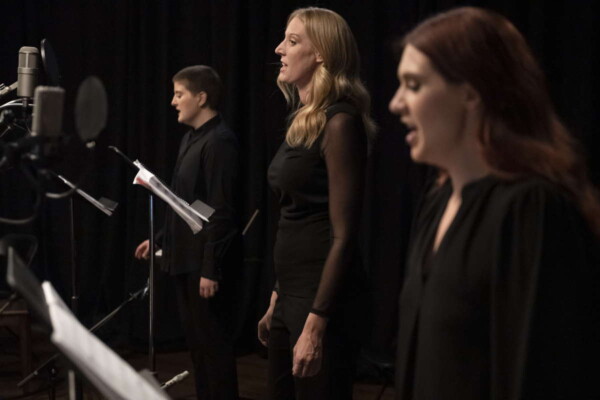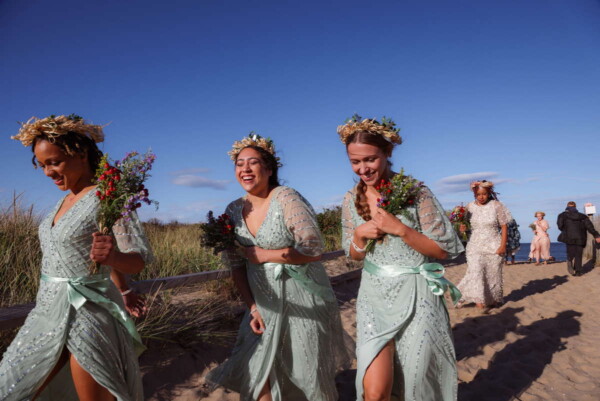Quick: when was the last time you saw an opera with hardly any men in it? In Ana Sokolović’s Svadba, the (virtual) curtain rises on a world which is beyond the male gaze – at least temporarily. It is the eve of a wedding. A bride, Milica, is surrounded by her wedding attendants, a group of friends and relatives. In this production, their actions take place under the watchful, caring eyes of the Ancestors, a group of female storytellers who guide their preparations for the festivities to come. From a cottage perched on land’s limit by the seashore, and on the precipice of a life transition which will permanently alter their relationship to one another, Milica and her friends celebrate and sing. At this ephemeral crossroads, we glimpse the vitality of these figures’ connections as they make sense of themselves, their pasts, and their futures.
Given the central visibility and creative power that men historically have wielded in opera as composers, conductors, artists, and directors, a work like Svadba – written by a female composer for six soprano and mezzo-soprano voices – stands as something of a rarity. Indeed, it would be easy to define Svadba by what is absent from it: not only are there are no male voices, but there is also no orchestra, and there are almost no arias in the conventional sense. In the absence of familiar character archetypes (the amorous tenor, the villainous bass, the damsel-in-distress soprano), conventional social hierarchies dissolve. The audience is pleasantly unmoored. With their predictive capabilities lessened by unfamiliarity, listeners take on the role of eavesdroppers, listening in on a world that stretches beyond the horizon of their expectations.
 Yet even as Svadba radically disrupts some operatic norms, it also presents a conservative work in the most literal sense of the term: it conserves tradition. The piece is structured around a series of rituals, as Milica and her friends make decorations for the wedding, play games, adorn the bride’s hair, and make music together. There are also moments of mild discord: jealousy and arguments among the party, the stuff of longstanding friendships. The overlapping presence of both the Ancestors (whose voices we hear) and Contemporaries (whose bodies and movements we see) heightens this sense of continuity between past and present. When Milica dreams of her wedding day, an ecstatic blur of romance and beauty, the Ancestors are there to guide her. She may not know precisely what her life will hold once she marries, but she knows well the foundations upon which it will be built. Fundamentally, the opera is about transitions, not disruptions; junctures, not breaks.
Yet even as Svadba radically disrupts some operatic norms, it also presents a conservative work in the most literal sense of the term: it conserves tradition. The piece is structured around a series of rituals, as Milica and her friends make decorations for the wedding, play games, adorn the bride’s hair, and make music together. There are also moments of mild discord: jealousy and arguments among the party, the stuff of longstanding friendships. The overlapping presence of both the Ancestors (whose voices we hear) and Contemporaries (whose bodies and movements we see) heightens this sense of continuity between past and present. When Milica dreams of her wedding day, an ecstatic blur of romance and beauty, the Ancestors are there to guide her. She may not know precisely what her life will hold once she marries, but she knows well the foundations upon which it will be built. Fundamentally, the opera is about transitions, not disruptions; junctures, not breaks.
The rituals at the heart of Svadba compel its characters to face inward – toward one another and toward the shared world of their village by the sea. Much of what the opera’s six characters sing is resolutely non-declamatory. Rather than each casting their voices outward toward an audience or an orchestra, they inhabit a shared sound. In the opera’s earliest moments, a first note voiced in unison slips into close intervals by half-steps, as individual singers extend away almost imperceptibly. Later, more playful moments feature virtuosic pitter-patter, rapid-fire exchanges back and forth among small groups. These vocal techniques create a sense of internal cohesion, a sonic texture guided by intimacy, curiosity, and closeness.
 This production’s cinematic format, which necessarily creates distance between artist and audience, is perhaps especially well-suited to Svadba, given its focus on close-knit social relationships. Lena’s seaside cottage, where the bridal party gathers, becomes an entirely self-contained space. We can only observe from a distance, much as we cannot venture into the fantastical dreamscapes in which Milica imagines her wedding day in all its glory. This is a world which belongs wholly to the Contemporaries and the Ancestors.
This production’s cinematic format, which necessarily creates distance between artist and audience, is perhaps especially well-suited to Svadba, given its focus on close-knit social relationships. Lena’s seaside cottage, where the bridal party gathers, becomes an entirely self-contained space. We can only observe from a distance, much as we cannot venture into the fantastical dreamscapes in which Milica imagines her wedding day in all its glory. This is a world which belongs wholly to the Contemporaries and the Ancestors.
At the same time, Svadba’s musical language emerges directly from Sokolović’s previous work. Much of the composer’s writing for women’s voices, including the 2000 piece Six voix pour six reines (Six Voices for Sirens), the 2005 opera The Midnight Court, and the 2008 mono-opera Love Songs, climbs into the highest parts of the human vocal range. The writing is unfailingly virtuosic: sustained phrases converge with propulsive ostinatos, syllabic bursts of sound, and luxuriant glissandi. In Svadba, the cumulative effect of these technical innovations is oceanic in scope: like the opera’s characters, dancing by the seaside, our ears reach out to a strange, distant horizon, buoyed by waves upon waves of sound.
“I’m especially attracted to opera precisely due to the sensory complexity it engenders, as well as to the way it combines all those different arts,” Sokolović has explained. In Svadba, that complexity takes shape not only through vocal writing, but also through language and instrumentation. The opera’s libretto is mostly in Serbian – yet the language is transmuted and altered to such an extent that, as Sokolović wryly notes, even a native speaker would likely find much of it beyond their comprehension. The lack of orchestral instruments means that vocal sound and narrative action occupy the whole of the listener’s attention. Soprano and mezzo-soprano voices, in this context, take on a world-shaping quality; they are the building blocks of Svadba’s entire sonic universe.
Yet for all its musical adventurousness, Svadba stays firmly rooted in a familiar set of rituals and traditions. “I wanted anyone in the world to understand this even without understanding the words,” Sokolović says. Milica and her friends are not blank slates, exactly, but they are sketched with notable generality. We know nothing about Milica’s betrothed or why she loves them; about the years of friendship that surely shaped her relationship to her wedding attendants; about what the opera’s characters think of one another beyond the flashes of fondness and jealousy that emerge at key moments throughout. This lack of specificity is, perhaps paradoxically, a stabilizing force: the audience can easily identify with the characters’ ritual preparations for the wedding and focus on family and friendship. They can imagine themselves taking part in similar acts. Through this combination of sonic strangeness and dramatic familiarity, Svadba expands our conception of what a woman’s voice can do without necessarily challenging conventional notions of what a woman herself can do.
 In the opera’s final scene, Milica sings a beautiful, affecting aria, anticipating her marriage and her changed life beyond. She bids farewell to the past with a plaintive, languid melody, singing alone. Her friends join in almost imperceptibly, then offer gentle encouragement: “Off you go, sweet Milica!” She is comforted by their support, and her vocal line gradually melts into theirs. The old and the new coalesce as Milica embarks upon a new journey. Toeing the ever-shifting line between innovation and tradition, Svadba reorients the audience toward new sounds while reminding us that a safe harbor still awaits.
In the opera’s final scene, Milica sings a beautiful, affecting aria, anticipating her marriage and her changed life beyond. She bids farewell to the past with a plaintive, languid melody, singing alone. Her friends join in almost imperceptibly, then offer gentle encouragement: “Off you go, sweet Milica!” She is comforted by their support, and her vocal line gradually melts into theirs. The old and the new coalesce as Milica embarks upon a new journey. Toeing the ever-shifting line between innovation and tradition, Svadba reorients the audience toward new sounds while reminding us that a safe harbor still awaits.
Lucy Caplan, Ph.D., is a scholar and critic based in Cambridge, Massachusetts. She teaches at Harvard University and is writing a book about African American opera in the early twentieth century.
Images:
- BLO-2021-SVA-14-sm: Photo by Liza Voll

